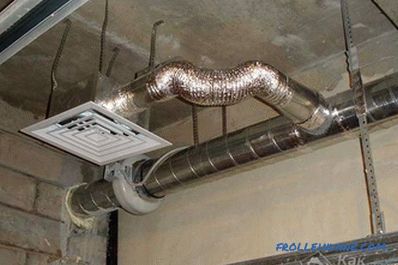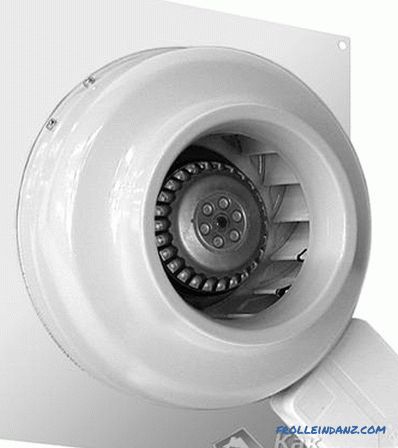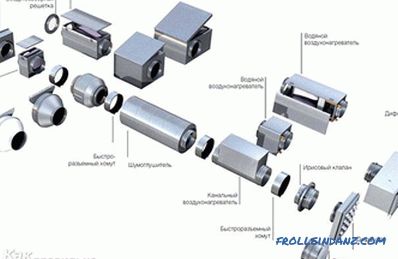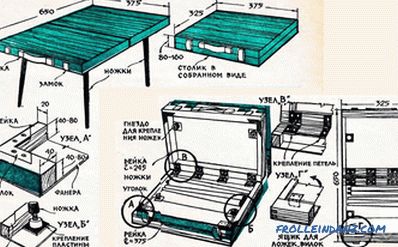Every car owner wants his “iron horse” to retain all his great qualities and excellent appearance for as long as possible. Almost all motorists rightly believe that storing the car in the garage will significantly extend his "life". If the garage is improperly constructed (absence or poor ventilation), corrosion may appear on the car body - initially in places where the paint is damaged, but later this insidious process begins to spread rapidly. To prevent this, consider how to properly make the ventilation of the garage. First of all, you should understand the basic functions of ventilation.
Functions
 Ventilation functions
Ventilation functions
- Removing water vapor that inevitably formed due to falling into the garage of snow, dirt, raindrops along with the car.
- Removal from the garage of gases and vapors harmful to humans.
- Drying the body of a wet car (after using it in rain or snow).
- The timely removal of condensate formed on the ceiling and walls of the garage ensures the safety of the structural elements of the garage.
- Drying of the observation pit and cellar (if any).
Types
 Types of ventilation systems
Types of ventilation systems
For organizing ventilation systems in garages use the following main types of systems:
- natural;
- combined;
- mechanical.
Let us consider their action principle in more detail.
Natural ventilation system
 Natural ventilation of the garage
Natural ventilation of the garage
It is the easiest and cheapest way to ventilate the garage. Due to this, many garage owners opt for just such a system.
The air inflow into the garage is provided by air inlets on the side (at the bottom), protected by a grill or louver. The flow of fresh air, passing along the car and under its bottom, is mixed with the internal air and is removed from the garage through an exhaust device - a deflector. The deflector is installed on the roof directly above the exhaust duct mounted on the side opposite the gate. For reliable operation of this ventilation system, it is necessary to ensure that an air duct made of tin or an asbestos pipe rises 50 cm above the roof and insulate it to prevent condensation from accumulating.
 In a garage with a basement
In a garage with a basement
Air circulation is ensured by the difference in density between the outside and exhaust air, and also due to wind exposure. In the case when the natural ventilation system does not cope, then you can use the exhaust ventilation of the combined type.
Combined exhaust ventilation
 Exhaust duct fan This system combines the natural (inlet) and mechanical (exhaust) parts of the ventilation system . To organize the forced outflow of air from the garage into the outlet duct, an electric fan is installed. While the fan is running, exhaust air from the garage is pushed into the atmosphere, freeing up space for fresh air flowing naturally through the intake pipe.
Exhaust duct fan This system combines the natural (inlet) and mechanical (exhaust) parts of the ventilation system . To organize the forced outflow of air from the garage into the outlet duct, an electric fan is installed. While the fan is running, exhaust air from the garage is pushed into the atmosphere, freeing up space for fresh air flowing naturally through the intake pipe.
When choosing a fan, besides the quality characteristics, it is necessary to consider the power consumption (preferably about 100 W) and continuous operation. If necessary, the system is equipped with a time relay. The disadvantages of this system include the overcooling of the garage during the winter period and the lack of filtration of incoming air.
Mechanical
 Supply air scheme
Supply air scheme
In this case, the inflow and the air is removed by separate subsystems (supply and exhaust), which allows to get rid of the drawbacks characteristic of the already listed options.
The inlet subsystem. It consists of a filter (for filtering the incoming air), an electric air heater necessary for heating the air, and a fan.
Exhaust subsystem. It consists of an axial fan, in addition to which a duct fan with an air duct can be used.
 Monoblock
Monoblock
When organizing mechanical ventilation can be used:
- Modular design. Assumes installation of separate, operating independently units for organizing the inflow and exhaust of air. They are combined into one system using special sensors.
- Monoblock. It is the only unit performing the functions of inflow and exhaust. The most effective are monoblocks, equipped with plate heat exchangers, allowing to reduce the power consumption for heating the incoming air.
How to choose
 Ventilation grids
Ventilation grids
With a view of the ventilation system It is important to determine the design stage of the garage in order to properly fit it into the overall layout of the garage and eliminate the occurrence of unnecessary alterations.
It is recommended to install high-quality grilles or louvres on the ventilation holes. In addition to protecting the garage from debris, vandals and rodents, this will allow changing the flow area.
A mechanical ventilation system is best suited for heated garages, and a natural ventilation system is best for unheated ones. For underground garages used exclusively mechanical ventilation system.
Proper ventilation in the garage will maintain the optimum level of humidity due to air exchange, create a normal microclimate and keep your car in its original state.
Video
This can be homemade ventilation in the garage:




